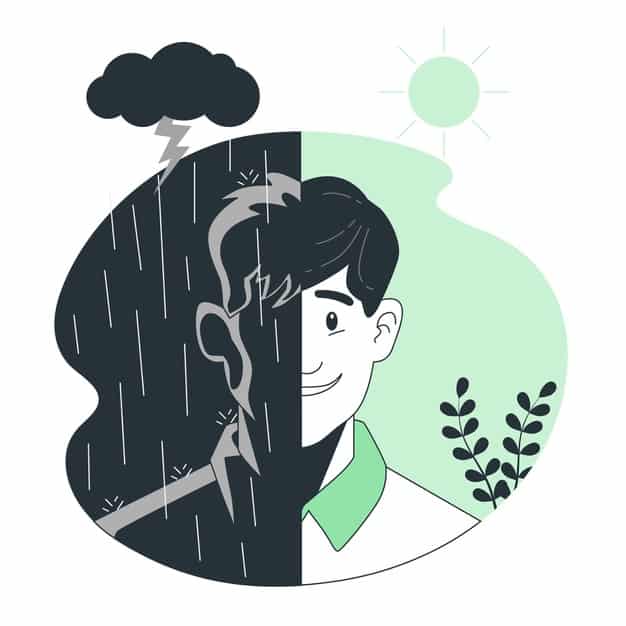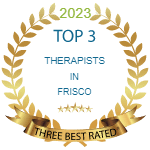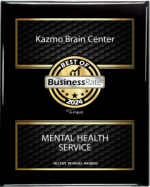Bipolar 1 Disorder and Bipolar 2Disorder: What Are the Differences?
Most people have emotional ups and downs from time to time. But if you have a brain condition called bipolar disorder, your feelings can reach abnormally high or low levels.
Sometimes you may feel immensely excited or energetic. Other times, you may find yourself sinking into a deep depression. Some of these emotional peaks and valleys can last for weeks or months.
There are four basic types of bipolar disorder:
- Bipolar 1 disorder
- Bipolar 2 disorder
- Cyclothymic disorder (cyclothymia)
- Other specified and unspecified bipolar and related disorders
Bipolar 1 and 2 disorders are more common than the other types of bipolar disorder. Read on to learn how these two types are alike and different.
Bipolar 1 vs. Bipolar 2
All types of bipolar disorder are characterized by episodes of extreme mood. The highs are known as manic episodes. The lows are known as depressive episodes.
The main difference between bipolar 1 and bipolar 2 disorders lies in the severity of the manic episodes caused by each type.
A person with bipolar 1 will experience a full manic episode, while a person with bipolar 2 will experience only a hypomanic episode (a period that’s less severe than a full manic episode).
A person with bipolar 1 may or may not experience a major depressive episode, while a person with bipolar 2 will experience a major depressive episode.
What is Bipolar 1 Disorder?
You must have had at least one manic episode to be diagnosed with bipolar 1 disorder. A person with bipolar 1 disorder may or may not have a major depressive episode. The symptoms of a manic episode may be so severe that you require hospital care.
Manic episodes are usually characterized by the following:
- Exceptional energy
- Restlessness
- Trouble concentrating
- Feelings of euphoria (extreme happiness)
- Risky behaviors
- Poor sleep
The symptoms of a manic episode tend to be so obvious and intrusive that there’s little doubt that something is wrong.
What is Bipolar 2 Disorder?
Bipolar 2 disorder involves a major depressive episode lasting at least two weeks and at least one hypomanic episode (a period that’s less severe than a full-blown manic episode). People with bipolar 2 typically don’t experience manic episodes intense enough to require hospitalization.
Bipolar 2 is sometimes misdiagnosed as depression, as depressive symptoms may be the major symptom at the time the person seeks medical attention. When there are no manic episodes to suggest bipolar disorder, the depressive symptoms become the focus.
What Are the Symptoms of Bipolar Disorder?
As mentioned above, bipolar 1 disorder causes mania and may cause depression, while bipolar 2 disorder causes hypomania and depression. Let’s learn more about what these symptoms mean.
Mania
A manic episode is more than just a feeling of elation, high energy, or being distracted. During a manic episode, the mania is so intense that it can interfere with your daily activities. It’s difficult to redirect someone in a manic episode toward a calmer, more reasonable state.
People who are in the manic phase of bipolar disorder can make some very irrational decisions, such as spending large amounts of money that they can’t afford to spend. They may also engage in high-risk behaviors, such as sexual indiscretions despite being in a committed relationship.
An episode can’t be officially deemed manic if it’s caused by outside influences such as alcohol, drugs, or another health condition.
Hypomania
A hypomanic episode is a period of mania that’s less severe than a full-blown manic episode. Though less severe than a manic episode, a hypomanic phase is still an event in which your behavior differs from your normal state. The differences will be extreme enough that people around you may notice that something is wrong.
Officially, a hypomanic episode isn’t considered hypomania if it’s influenced by drugs or alcohol.
Depression
Depressive symptoms in someone with bipolar disorder are like those of someone with clinical depression. They may include extended periods of sadness and hopelessness. You may also experience a loss of interest in people you once enjoyed spending time with and activities you used to like. Other symptoms include:
- Tiredness
- Irritability
- Trouble concentrating
- Changes in sleeping habits
- Changes in eating habits
What Causes Bipolar Disorder?
Scientists don’t know what causes bipolar disorder. Abnormal physical characteristics of the brain or an imbalance in certain brain chemicals may be among the main causes.
As with many medical conditions, bipolar disorder tends to run in families. If you have a parent or sibling with bipolar disorder, your risk of developing it is higher. The search continues for the genes which may be responsible for bipolar disorder.
Researchers also believe that severe stress, drug or alcohol abuse, or severely upsetting experiences may trigger bipolar disorder. These experiences can include childhood abuse or the death of a loved one.
How is Bipolar Disorder Diagnosed?
A psychiatrist or other mental health professional typically diagnoses bipolar disorder. The diagnosis will include a review of both your medical history and any symptoms you have that are related to mania and depression. A trained professional will know what questions to ask.
It can be very helpful to bring a spouse or close friend with you during the doctor’s visit. They may be able to answer questions about your behavior that you may not be able to answer easily or accurately.
If you have symptoms that seem like bipolar 1 or bipolar 2, you can always start by telling your doctor. Your doctor may refer you to a mental health specialist if your symptoms appear serious enough.
A blood test may also be part of the diagnostic process. There are no markers for bipolar disorder in the blood, but a blood test and a comprehensive physical exam may help rule out other possible causes for your behavior.
How is Bipolar Disorder Treated?
Doctors usually treat bipolar disorder with a combination of medications and psychotherapy.
Mood stabilizers are often the first drugs used in treatment. You may take these for a long time.
Lithium has been a widely used mood stabilizer for many years. It does have several potential side effects. These include low thyroid function, joint pain, and indigestion. It also requires blood tests to monitor the therapeutic levels of the drug as well as kidney function. Antipsychotics can be used to treat manic episodes.
Your doctor may start you on a low dose of whichever medication you both decide to use to see how you respond. You may need a stronger dose than what they initially prescribe. You may also need a combination of medications or even different medications to control your symptoms.
All medications have potential side effects and interactions with other drugs. If you’re pregnant or you take other medications, be sure to tell your doctor before taking any new medications.
Writing in a diary can be an especially helpful part of your treatment. Keeping track of your moods, sleeping and eating patterns, and significant life events can help you and your doctor understand how therapy and medications are working.
If your symptoms don’t improve or get worse, your doctor may order a change in your medications or a different type of psychotherapy.
Is Treatment for Bipolar 1 Different From Treatment for Bipolar 2?
Treatment for bipolar disorder, formerly called manic-depression, generally involves medications and forms of psychotherapy — whether you have bipolar I or bipolar 2. Bipolar 2 disorder is not a milder form of bipolar 1 disorder, but a separate diagnosis.
While the manic episodes of bipolar 1 disorder can be severe and dangerous, individuals with bipolar 2 disorder can be depressed for longer periods, which can cause significant impairment with substantial consequences.
The types and doses of medications prescribed are based on your particular symptoms. Whether you have bipolar 1 or 2, medications may include:
- Mood stabilizers. You’ll typically need mood-stabilizing medication to control episodes of mania or hypomania, which is a less severe form of mania. Examples of mood stabilizers include lithium (Lithobid), valproic acid (Depakene), divalproex sodium (Depakote), carbamazepine (Tegretol, Equetro, others) and lamotrigine (Lamictal).
- Antipsychotics. Your psychiatric care provider may add an antipsychotic medication such as olanzapine (Zyprexa), risperidone (Risperdal), quetiapine (Seroquel), aripiprazole (Abilify), ziprasidone (Geodon), lurasidone (Latuda), cariprazine (Vraylar) or asenapine (Saphris). Your provider may prescribe some of these medications alone or along with a mood stabilizer.
- Antidepressants. Your provider may add an antidepressant or one of the other medications used to treat bipolar disorder that has antidepressant effects to help manage depression. Because an antidepressant can sometimes trigger a manic episode, it needs to be prescribed along with a mood stabilizer or antipsychotic in bipolar disorder.
- Antidepressant-antipsychotic. The medication Symbyax combines the antidepressant fluoxetine and the antipsychotic olanzapine. It works as a depression treatment and a mood stabilizer. Symbyax is approved by the Food and Drug Administration specifically for the treatment of depressive episodes associated with bipolar I disorder.
In addition to medication for bipolar disorder, other treatment approaches include:
- Psychotherapy. As a key part of treatment, your psychiatric care provider may recommend cognitive behavioral therapy to identify unhealthy, negative beliefs and behaviors and replace them with healthy, positive ones. Other types of therapy also may help, such as social rhythm therapy — establishing a consistent routine for better mood management.
- Substance abuse treatment. Many people with bipolar disorder also have alcohol, tobacco or drug problems. Drugs or alcohol may seem to ease symptoms, but they can actually trigger, prolong or worsen depression or mania. If you have a problem with alcohol or other drugs, tell your provider so that both your substance use and bipolar disorder can be treated.
- Treatment programs. Participation in an outpatient treatment program for bipolar disorder can be very beneficial. However, your provider may recommend hospitalization if your bipolar disorder significantly affects your functioning or safety.
- Self-management strategies. In addition to medications and other types of treatment, successful management of your bipolar disorder includes living a healthy lifestyle, such as getting enough sleep, eating a healthy diet and being physically active. Keeping to a regular schedule, getting involved in social activities and joining a support group may also help. If you need advice in these areas, talk with your provider.
You may need to try different medications or combinations of medications to determine what works best. So it’s important to regularly meet with your psychiatric care provider to see how well your treatment is working. If necessary, your provider may make periodic adjustments to your medication to keep symptoms and side effects under control.
What is The Outlook?
Bipolar disorder isn’t curable. But with proper treatment and support from family and friends, you can manage your symptoms and maintain your quality of life.
You must follow your doctor’s instructions regarding medications and other lifestyle choices. This includes:
- Alcohol use
- Drug use
- Exercise
- Diet
- Sleep
- Stress reduction
Including your friends and family members in your care can be especially helpful.
It’s also helpful to learn as much as you can about bipolar disorder. The more you know about the condition, the more in control you may feel as you adjust to life after diagnosis.
You may be able to repair strained relationships. Educating others about bipolar disorder may make them more understanding of hurtful events from the past.
Support Options
Support groups, both online and in-person, can be helpful for people with bipolar disorder. They can also be beneficial for your friends and relatives. Learning about others’ struggles and triumphs may help you get through any challenges you may have.
The Depression and Bipolar Support Alliance maintain a website that provides:
- Personal stories from people with bipolar disorder
- Contact information for support groups across the United States
- Information about the condition and treatments
- Materials for caregivers and loved ones of those with the bipolar disorder
If you’ve been diagnosed with bipolar 1 or bipolar 2, you should always remember that this is a condition you can manage. You aren’t alone. Talk to your doctor or call a local hospital to find out about support groups or other local resources.
Resources: www.healthline.com







